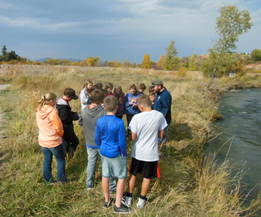Jr High, BLM Expand Brewery Flats Outdoor Laboratory
Organization:
Media Contact:
(LEWISTOWN, Mont.) – A new dimension has been added to Junior High outdoor education through a partnership with the Bureau of Land Management.

BLM Natural Resource Specialist Steve Smith leads
a group of 7th graders in a discussion about leafy
spurge. (BLM Photo by Zane Fulbright)
Lewistown Junior High science teachers Steve Paulson (retired), Suzie Flentie, and Brett Shelagowski have used Brewery Flats as an outdoor classroom since 1981.
Environmental work ended a decade ago at Brewery Flats, a former railroad switching yard and refinery site converted to an urban wildlife park during the past 20 years.
The first step in the site’s environmental reversal came when the Big Spring Creek Watershed Partnership, the Fergus Conservation District, the federal Natural Resource Conservation Service and the Montana Department of Fish, Wildlife and Parks discussed building a new stream channel at a fishing access managed by Fish, Wildlife and Parks.
By 2000, the creek was transformed into a meandering stream. What had been a straight channel lacked deep pools and shade for trout. Montana Fish, Wildlife and Parks funded the creation of a new, serpentine channel that boosted the trout population by some 75 percent.
Students have been monitoring overall water quality of Big Spring Creek at the Brewery Flats site, observing changes before and after the creek was realigned to its meandering state. Annually about 160 7th and 8th graders go to the site to collect the data. Since the project’s inception about 4,000 students have participated in water analysis and monitoring. Seventh grade students monitor sediment size, stream discharge, cross section depth, aquatic macro invertebrates, and water chemistry. Eighth graders use Vernier Labquest data collectors and sensors to collect temperature, flow rate and pH data.
During 2017, the Lewistown Field Office became involved in providing students with information about the local geology and invasive plant species. The expanded curriculum encouraged students to look beyond the stream channel and consider other factors affecting stream health. Archeologist Zane Fulbright and Natural Resource Specialist Steve Smith focused on the relationship between healthy riparian areas and local geology and invasive plant species. Correlating the sediment in the stream channel with Kootenai Formation sandstone found throughout the area, students looked around to see the relationship between rocks, landforms, plants, and hydrologic processes they had been measuring.
Smith helped students identify noxious and invasive plants in the riparian area, and distinguish annuals, biennials and perennials. He also quizzed the students on how weeds are spreading throughout the watershed, and effective ways to eradicate weeds. The discovery of a lone Russian olive led to the discussion of the challenges when some non-native plants, such as the Russian olive, are intentionally introduced but are no longer desired.
“By partnering with the BLM, the Lewistown Public Schools continue to expand the learning opportunities afforded their students, and the BLM continues to support the local community by helping educate the next generation of public land users and managers,” said BLM Lewistown Field Manager Pete McFadden. “Connecting kids to public lands connects them to America’s natural and cultural heritage.”
-BLM-
The BLM manages about 245 million acres of public land located primarily in 12 western states, including Alaska, on behalf of the American people. The BLM also administers 700 million acres of sub-surface mineral estate throughout the nation. Our mission is to sustain the health, diversity, and productivity of America’s public lands for the use and enjoyment of present and future generations.
